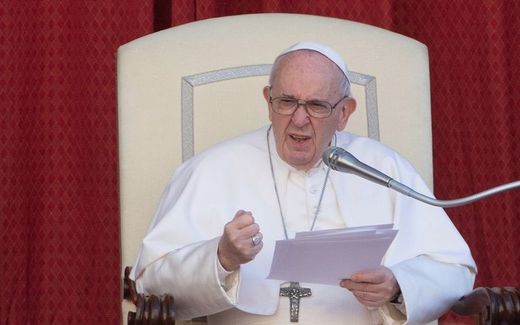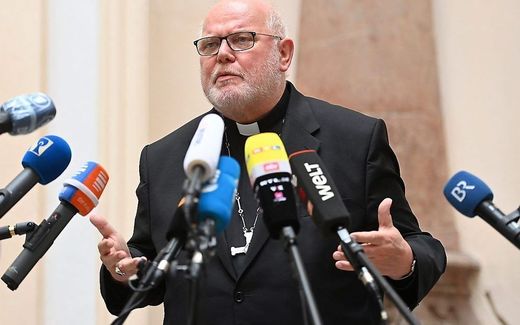Church to move after scathing abuse report
14-10-2021
Western Europe
Maarten Stolk, RD

The former minor seminary of Chavagnes-en-Paillers, in western France, where hundreds of children were abused in the 1950s, 60s and 70s. image AFP, Sebastien Salom-Gomis
Western Europe
Tens of thousands of children have been victims of sexual abuse by clergy in the Roman Catholic Church in France since 1950. These are shocking figures that a commission of inquiry released last week. What do they mean for the church? Four questions and answers.
What does the report say? The French bishops set up a commission of inquiry in late 2018 because they wanted more clarity about the abuse in their country and to restore trust in the church. The 22 doctors, historians, sociologists and theologians concluded that since 1950, a total of 2,900 to 3,200 clergymen had abused an estimated 216,000 children and adolescents - especially boys. Suppose victims of abuse committed by people with no official position in the church are included. In that case, there could be as many as 330,000 victims. The abuse occurred mainly in the first decades of the period under investigation.
How has there been a response to the revelations? The head of the independent commission, Jean-Marc Sauvé, said Monday (October 4th) during the presentation of the 2,500-page report that the problem of sexual abuse in the church still exists. He also criticized the church's attitude. For decades, until at least 2000, the church had shown indifference towards the victims of abuse. There was negligence, silence and a lack of measures against the abuse.
Pope Francis took note of the contents of the report "with pain." His "thoughts go first of all to the victims, with great sorrow for their wounds and gratitude for their courage to speak out." The pope said in 2018 that sexual abuse should be eradicated within the church.
Archbishop Éric de Moulins-Beaufort, the head of the French bishops' conference, said he felt "shame and horror" in response to the report. He also asked for forgiveness. Victims of the abuse are happy that a report is now on the table and that the church acknowledges guilt, though it has taken a long time. For others, the apology comes too late. It is also questionable what the church will do concretely for the victims to prevent future abuse.
German Chancellor Angela Merkel used a private visit to the pope on Thursday, October 7th, to reiterate the importance of the church acting against child abuse.
What do these figures say? First, that sexual abuse is relatively common within the French Church. The risk of abuse in the church is three times higher than in sports clubs, French journalist Christine Pedotti noted this week. She speaks of a "frightening" report, given the scale of the crimes, the silence surrounding the abuse, and the church's indifference to the victims.
The figures also show that the Roman Catholic Church in France was relatively late in having the abuse investigated and that the scale of the problem is rather large. Other countries came up with such investigations earlier. In the Netherlands, the Deetman Commission reported in 2011 that Roman Catholic clergy sexually abused nearly 2,000 children between 1945 and 2010. German research shows that at least 3677 minors were victims of sexual abuse in one diocese between 1946 and 2014. These have since paid out more than 19 million euros to the victims.
The number of perpetrators in France is estimated to be between 2,900 and 3,200, about 3 per cent of the total number of clergymen. That means that the vast majority of clergymen were not at fault, but also that each suspect would have made an average of seventy victims. "That is a lot, also compared to other countries," writes Vatican watcher Stijn Fens in the Dutch newspaper Trouw. "How that high number should be explained is not entirely clear. It could have something to do with the methodology the commission used in its investigation. For example, the number of victims was determined not only by archival research and interviews with victims but also by a survey of a representative group of 28,000 French people."
Abuse could take place mainly because of the closed culture in the church. A point of discussion remains whether compulsory celibacy encourages abuse. Still, most researchers point out that, on average, abuse occurs just as much in other situations where there is a position of power. A culture of cover-up did prevail in the church.
What will the church do next? The commission of inquiry also comes up with a series of recommendations in the report. Although many cases are time-barred, they call for, among other things, financial compensation for the victims. The commission also informed the prosecution of several abuse cases.
The consequences of such abuse reports are significant for the Roman Catholic Church. Not only is the church losing more and more authority in society, but many people are unsubscribing, and less money is coming in. For example, in Belgium, where secularization started later than in the Netherlands, hundreds of Roman Catholics had themselves deregistered or "de-baptized" in recent years. Even more significant is the tacit church abandonment.
The Roman Catholic Church has little choice but to continue its chosen path. Pope Francis launched a law in 2019 to combat sexual abuse in the Roman Catholic Church. This will require all clergymen and members of religious orders to report cases of sexual abuse to church authorities. There are also recommendations for the establishment of a hotline for victims and the involvement of secular authorities. And concrete help must be offered to victims.
This article was published previously in the Reformatorisch Dagblad on October 8th, 2021.
Related Articles





